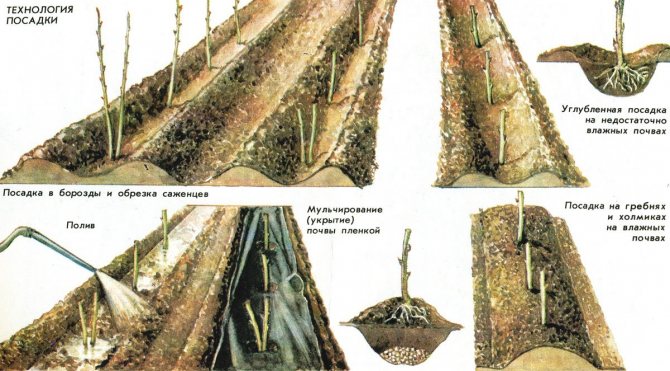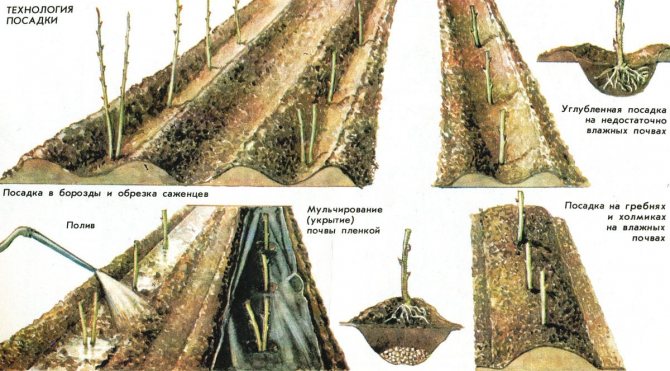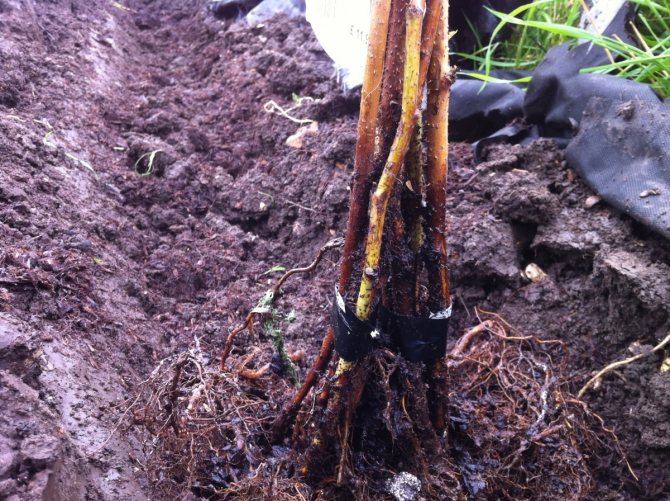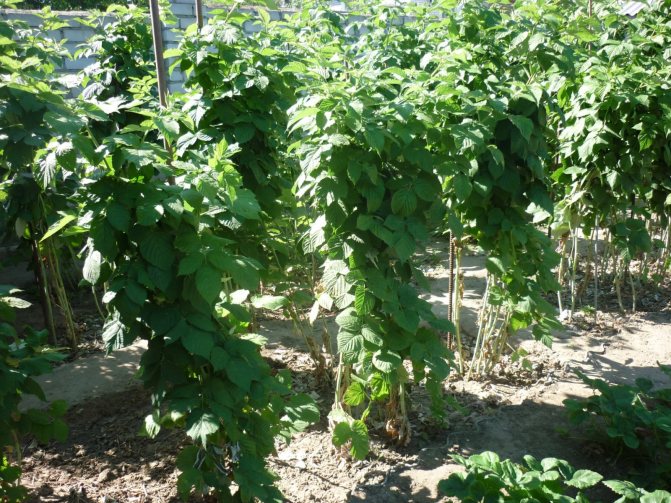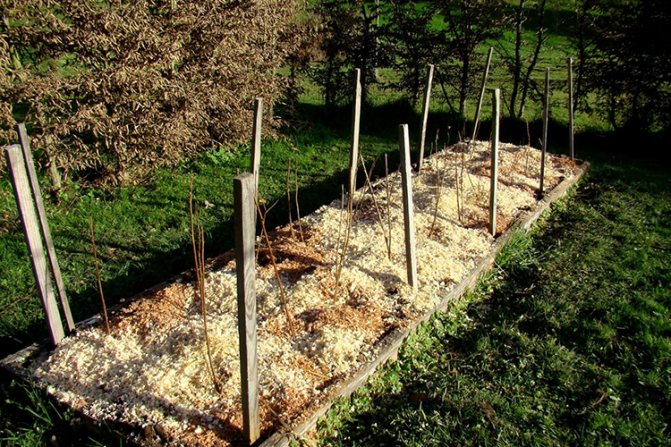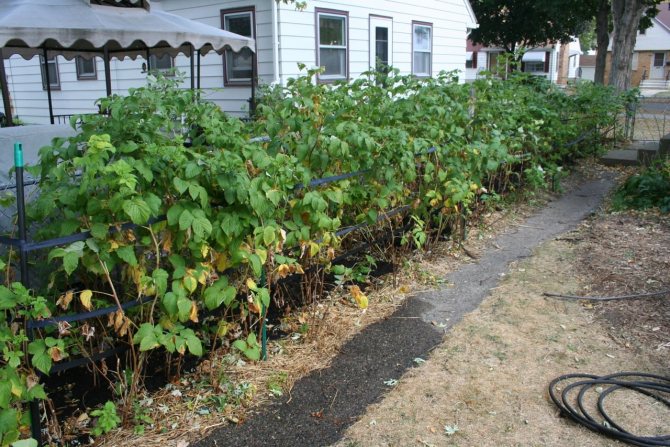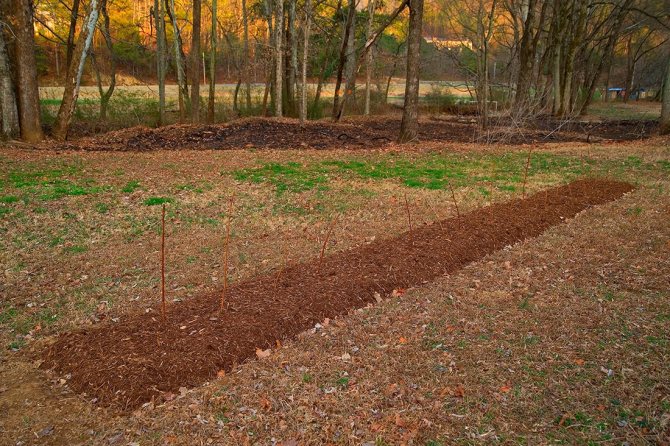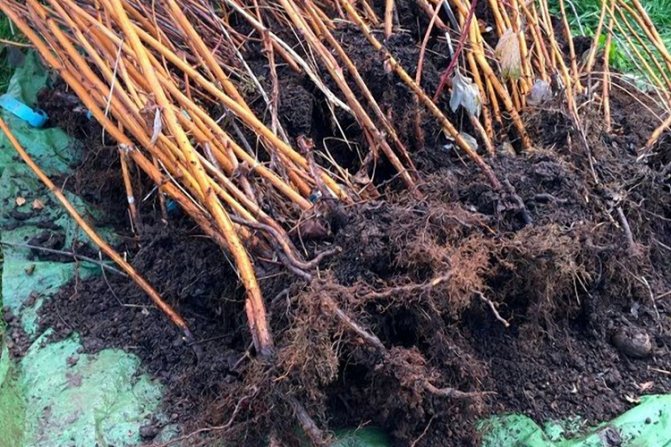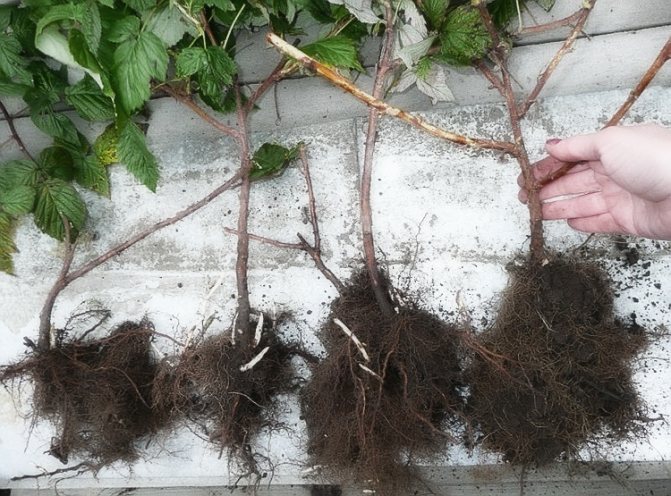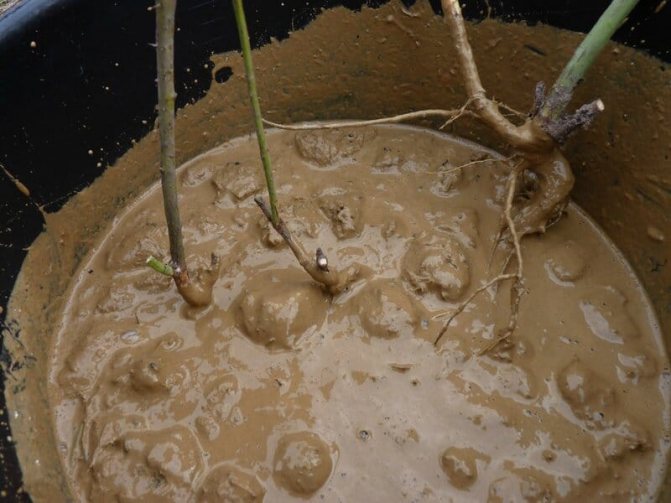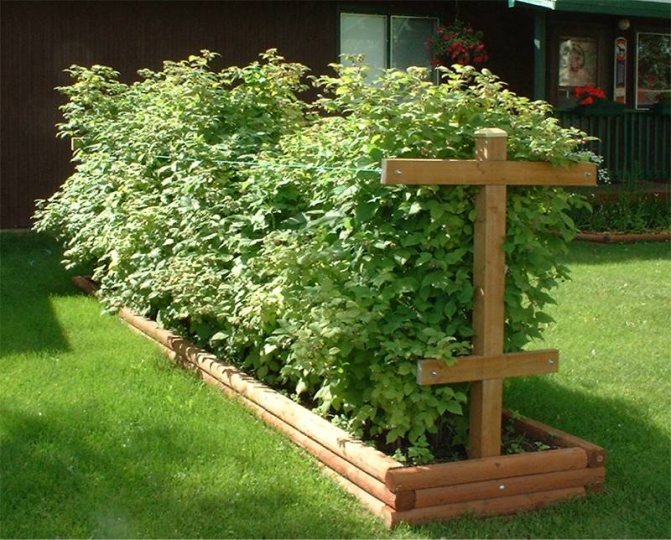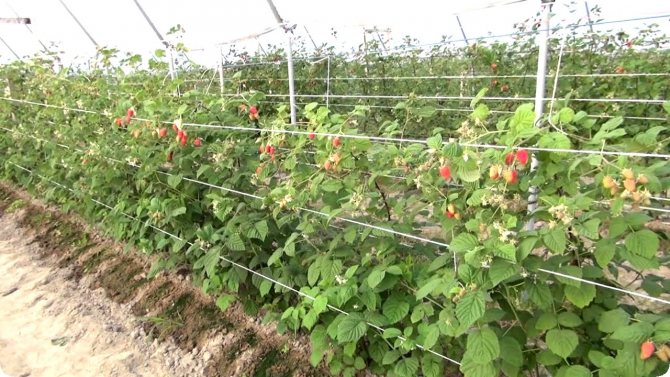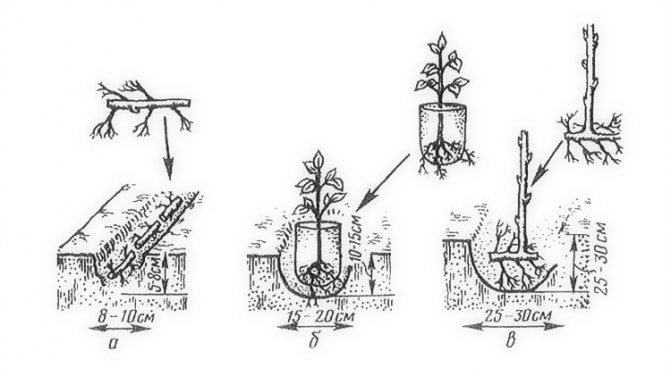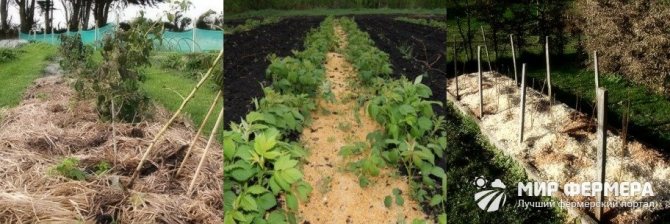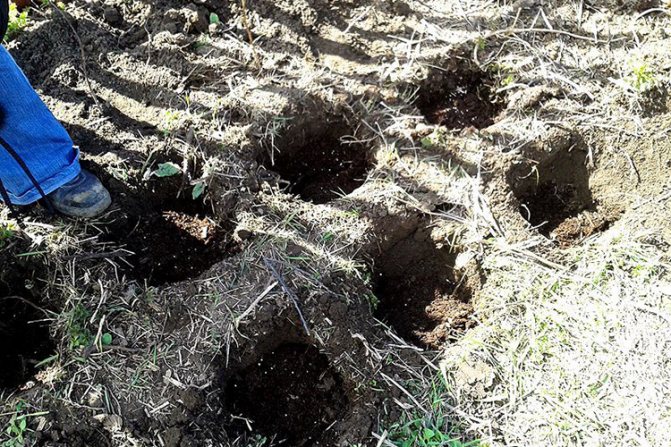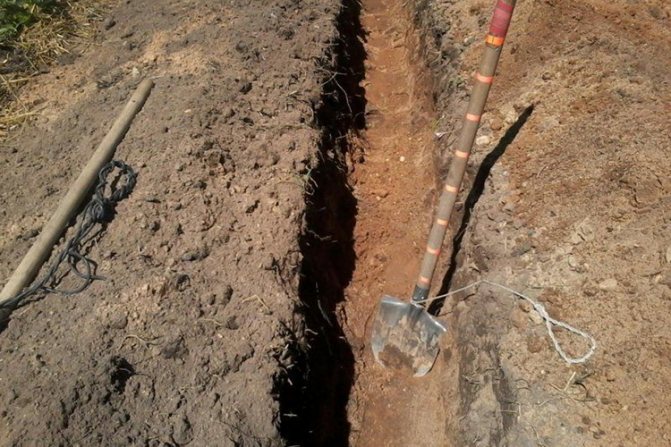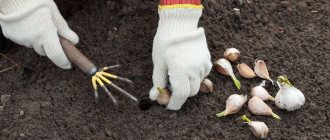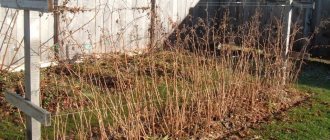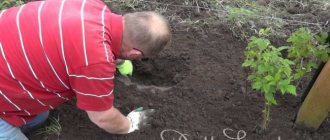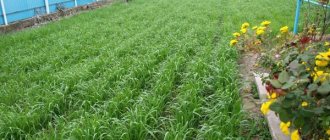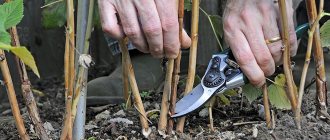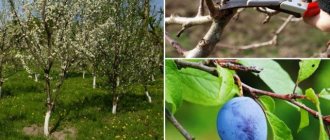»Gardening» Raspberry »Rules for planting raspberries in the fall
0
45
Article rating
Almost every gardener is engaged in the cultivation of raspberries - this crop is valued for its high and stable yield, unpretentiousness and good winter hardiness. Consider how to plant in the fall, and how to organize care.
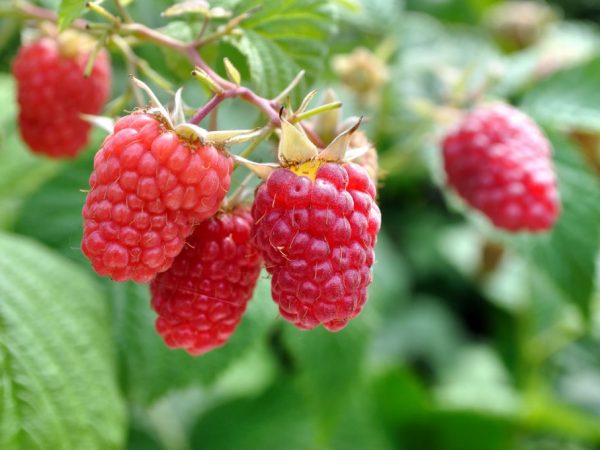
Rules for planting raspberries in the fall
Benefits of autumn planting
Many gardeners prefer the autumn planting of raspberries, because caring for seedlings during this period is much easier.
- Due to seasonal rainfall, the bushes receive the required amount of moisture, which has a beneficial effect on their growth and development.
- If the technology is observed, the culture safely survives the winter, and in the spring it begins to intensively grow green mass and roots.
- In addition, in the fall, when temperatures drop, the risk of disease and pest damage is minimal.
The only drawback is poor survival rate and rooting in case of violation of the terms. This usually happens if the procedure is carried out later than it should be.
Caring for raspberries after planting
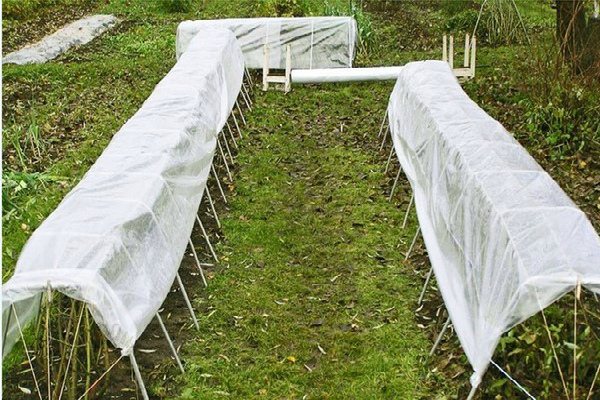

Further care for the planted seedlings is aimed at ensuring that they take root as quickly as possible and have time to take root before the arrival of winter. Care for the seedlings should be constant, so as not to cause drying of the branches or excessive moisture in the area at the base of the trunk, which will inevitably lead to rotting of the wood. Until about the end of October, raspberries are watered, guided by the state of the earth.
With a decrease in temperature, raspberries begin to prepare for wintering. As soon as the degree is closer to zero, the near-stem areas are mulched with sawdust or humus. The height of the protective layer must be at least 15 centimeters. Fallen foliage is not recommended to be used, since it is often a source of disease and a breeding ground for pests who like to feast on vegetable juice. In addition, in winter, rodents like to hide in it, which do not disdain to eat fresh wood of a raspberry bush in a hungry winter.
For the winter, the raspberry bushes need to be completely covered so that the young branches do not freeze. So that they do not break from the weight of the covering material, a wooden or metal frame is built around them, and a dense breathable fabric is pulled over it. It is especially important to build a protective frame for the bush planting method.
It has been proven that the frame shelter is the most optimal. It is warm under it in winter, while the air circulates well, which means that the plant breathes. With the arrival of spring, raspberry bushes are gradually exposed. First, they remove the mulch, and only then, when warm, clear weather sets in, the upper shelter is removed. It is important not to miscalculate the timing of the removal of the covering material, otherwise it will become too hot under the awning, condensation will begin to accumulate and the plant will resist. He will start sap flow ahead of time, the kidneys will begin to swell. And when the plant is released, it will instantly freeze or get sunburn.
Timing
Depending on the region, the time for planting bushes in open ground is different:
- in the south and in the middle lane, planting is allowed both in the spring (at the end of April or in the first decade of May) and in the fall (in the second half of September or at the beginning of October);
- in Siberia, in the North and the Urals, spring planting will be preferable, so that the seedlings have time to get stronger and prepare for winter;
- in the Moscow region and in the Leningrad region, it can be planted in spring or autumn (but no later than September 15).
Lunar calendar
Some gardeners plant according to the lunar calendar.
The most favorable days:
- in April - 7-8, 11-12, 24-25;
- in September - 15-16, 20-21.
When is it better to plant raspberries in autumn
In order for the plant to take root quickly, you need to know when to plant raspberries. The period of planting seedlings largely depends on the characteristics of the region in which the gardener and crop varieties live. The optimal period for planting a seedling is a month before the onset of frost. Most often, this period occurs at the end of September to mid-October. It is important to carefully examine the planting material and identify the period when it is ready for transplantation. The first sign of seedling maturity is the presence of clear replacement buds, which should form in the area of the root collar.
Preparation of seedlings
For successful cultivation, it is important to choose high-quality planting material. The best survival rate in plants with three cuttings and a massive developed root system.
The leaves of viable seedlings are bright green in color, the shoots are flexible without cracks, breaks, signs of yellowing, mold and various growths on the surface.
The branches should be no thinner than 1 cm, the optimal root length is from 10 cm.
This culture has very delicate roots that dry out quickly in the sun. Therefore, if you are not going to immediately plant raspberries, you need to dig it in a shaded place into a moist substrate of peat and sand mixed in the same amount.
Before planting, the length is cut so that the height of the plant does not exceed 30 cm.This manipulation will help the bush to take root better after transplanting and will contribute to the further development of the lateral stalks.
An hour before planting, the root system is examined for damage by diseases, pests, all dubious ones are often cut out, then irrigated with copper sulfate.
Immediately before planting, the roots of the bush are dipped in an infusion of mullein and clay - 1: 1 per 5 liters of water. The nutrient solution promotes better root growth and protects them from drying out.
Conditions, features
To plant raspberries in the fall successfully and without errors, you need to comply with the following conditions:
- you need to plant annual plants with a good root system. The length of the roots must be at least 10 cm;
- raspberries need to be planted in pre-prepared holes. The soil of the hole must be suitable for this plant variety;
- it is necessary to select a site well lit by the sun for the raspberry tree. The planting zone should be windless;
- you need to observe the temperature regime so that the air is warmed up by no more than 10-15 degrees Celsius;
- raspberry seedlings should be pruned, the length of the cutting should not exceed 25 cm;
- the shrub needs to be watered, for each plant, immediately after planting, a bucket of water leaves, then, within 3 days from the moment of planting, you need to spray the leaves of the seedling with water;
- at the end of planting, mulching must be done with peat, chopped straw or sawdust. This action will protect the young and tender roots of the plant from the cold winter;
- after planting a seedling, you need to easily pull it, checking the quality of work. If the bush succumbed to your effort, it is better to transplant it.
Important! Plant the plants no later than 30 days before frost. During this time, the plant will have time to adapt.
Organization of the place
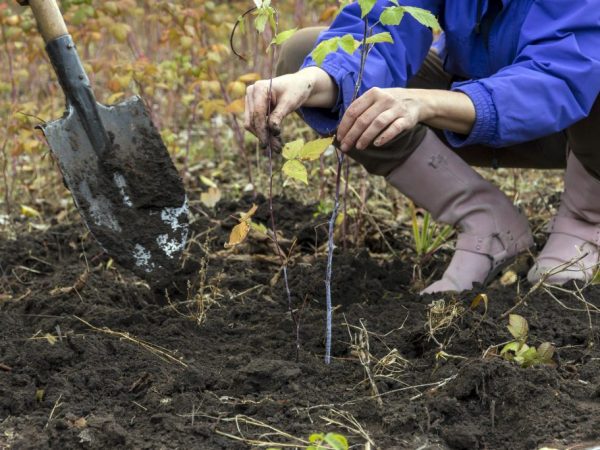

Raspberries need sunshine
For growing raspberries in the country, they choose a sunny place, protected from the wind and with a deep bed of groundwater.
It can be planted in a shaded area, but in such conditions, its yield will be much worse.
From a lack of lighting, the shoots are stretched, as a result, fruit buds are formed on unripe stems.With the arrival of the first cold weather, they will all freeze, and you will be left without a crop next year.
The best arrangement of the rows is from northeast to southwest. This berry culture grows well on loamy, sandy loam and sandy soil with a high content of organic and mineral substances. Poorly tolerates acidification, therefore, if the indicator is higher than 6 units, it is necessary to add 400 g of chalk, calcite, dolomite flour or slaked lime per 1 m².
The preparation of the site is carried out a month before planting, all volunteers, weeds, the remains of last year's vegetation are removed, dug up, leveled.
How to prepare a place for raspberries
Raspberries are demanding on placement conditions, if they are not suitable, the bushes will respond with a decrease in yield. Ideal if there is a corner protected from drafts, but illuminated by the sun. Here raspberries will feel at ease.
According to the rules of agricultural technology, a plot for a raspberry tree is prepared in 2 years, while growing siderates here at this time - alfalfa or clover. If someone has already given you seedlings or there is no desire to wait so long, you can see the site where perennial weeds previously grew. For this reason, virgin soil is often plowed under raspberries, choosing the roots of plants.
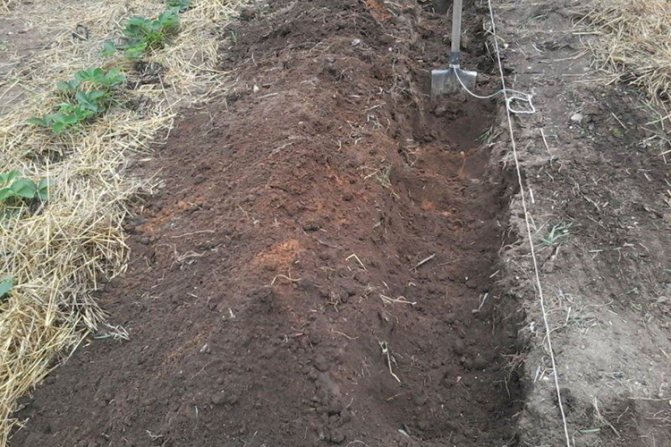

The soil should be light, ideally sandy loam. High acidity of the soil is unfavorable for raspberries. Inspect the site and, if horsetail grows in abundance on it, add lime, chalk or dolomite flour to the soil before planting.
You cannot plant raspberries in a place where potatoes, tomatoes or strawberries were previously grown.
Planting methods
Autumn planting of raspberries is carried out according to the following instructions:
- the root system pre-soaked in a nutrient solution is lowered into the ground, the roots are straightened;
- sprinkle with garden soil, tamp in the near-trunk zone;
- watered, then mulched with peat or last year's manure to prevent rapid evaporation of moisture.
It is allowed to plant no more than two shoots in one hole. With such a cultivation, the seedlings will not suffer from a lack of moisture, lighting and nutrients.
There are also several methods, the technology of which is slightly different from the standard one.
Trench
The main advantages of the method are that all bushes receive uniform and equal nutrition, moisture, therefore, fruiting is stable.
Trenches are harvested two weeks before planting - they prepare the soil, free it from weeds, dig it to a depth of 0.5 m.A mixture of superphosphate (100 g), ash (1 kg) and last year's manure (12 kg) is laid on the bottom.
It is forbidden to use nitrogen fertilizers during planting - they inhibit the development of the root system and stimulate an intensive build-up of green mass.
To avoid the growth of weeds, the aisles are covered with foil or agrofibre. The number of trenches and their length depends on the size of the future raspberry tree.
Dimple
The landing pits are prepared a week before planting. The optimal parameters are 40x40 cm. Scheme - the distance between the bushes is 1 m, in a row - 1.5 m.
Sand is poured at the bottom to create good drainage, then the nutrient mixture used for trench planting is placed on top. To avoid burning the roots, sprinkle the fertile soil mixture with a thin layer of garden soil.
Bush
An equally popular method, which consists in planting raspberries at a distance of 1.5 m. During the season, the bush grows, and after a few years about 10 developed and strong shoots appear on it.
The thinnest and weaker ones are cut annually in the spring, resulting in a plant with a fluffy crown.
In the container
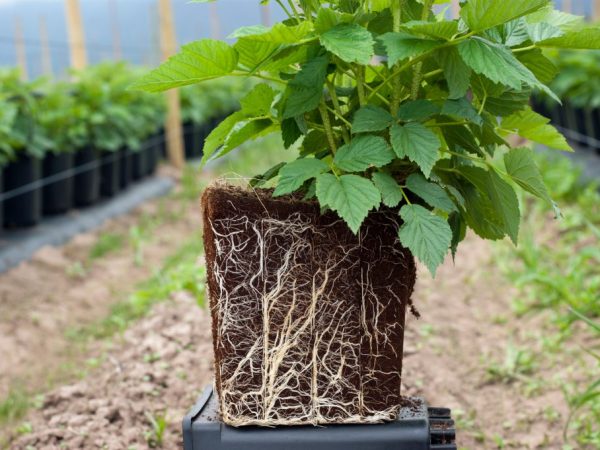

Growing in pots prevents shrubs from growing
This method is suitable for owners of small plots who want to grow other fruit and berry crops in addition to raspberries. For planting, take containers measuring 50x50 cm.
The bottom is cut out, installed in a pre-prepared pit filled with drainage and fertile composition. In such conditions, the shrub will not grow and take up a lot of space in the garden.
Tape
It can also be planted in open ground using the belt method, which is similar to trench planting. The only difference is that they dig out wider pits up to 1 m, and the seedlings in them are placed in two or three rows at a distance of 20 cm.
Garden world remontant raspberry. Repaired raspberry. How I picked up the varieties


"Indian Summer" will ripen in a vase Yesterday I cut off the branches most sprinkled with berries, put some in a vase, and the largest in a bucket in a warm dressing room. Gathered some berries. I will clarify: a little, because for 10 days we were not on the site, a lot of berries just deteriorated, a lot lay under the bushes.
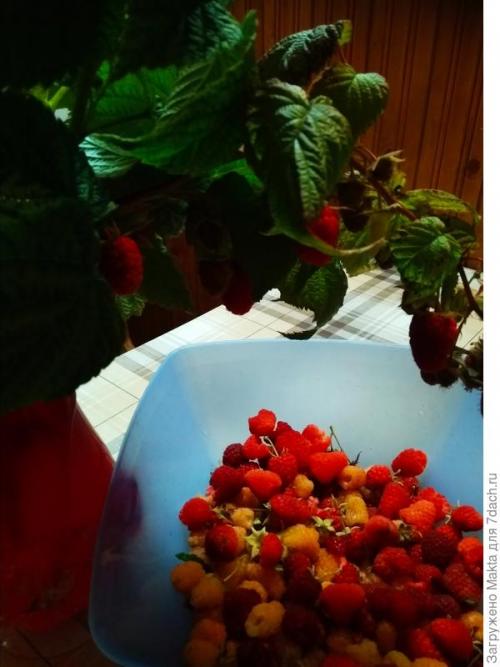

Different berries At night it was -2 degrees. In the morning, the shoots with berries left in the garden were covered with ice, but they thawed out in the autumn sun, as if nothing had happened.
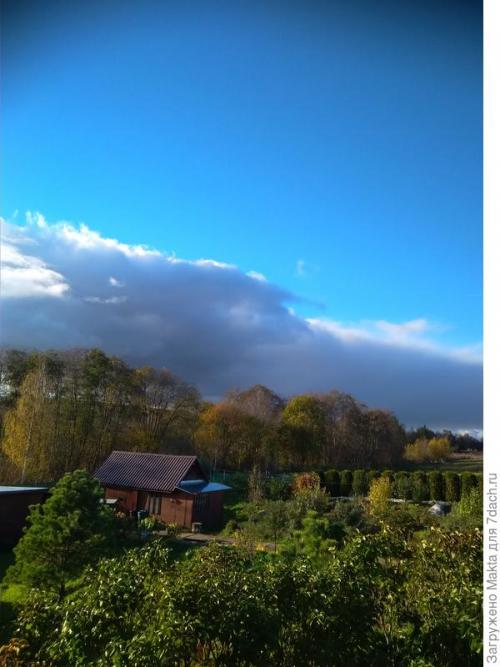

The morning of October 9 after the night frost Of course, the berries in the dishes will not become the same as they are in the sun, but for October, in Kostroma conditions, this is good. Many gardeners do not favor remontant raspberries, they say, they have no raspberry aroma, and their ripening depends on the weather conditions in August and September. In these months, as a rule, the nights are already cold, as it ripens here. I will take the liberty of sharing reflections based on my own experience. Raspberries are a favorite berry in my family, so it took a long time to select varieties. The main selection criterion is sweet taste, followed by early maturity. The exception is the Nizhegorodets variety. There is a slight sourness in it, but completely harmonious.


Nizhegorodets at the beginning of August Berries should be picked when they are easily removed from the stalk, as a rule, with a slight pressure. Somehow I had a chance to watch video
about "Nizhegorodets", all the berries in the basket were with stalks, the authors talked about the sweet and sour taste and the transportation of berries. This is what sellers usually do. We, therefore, are happier than them, we tasted the right taste of this variety.
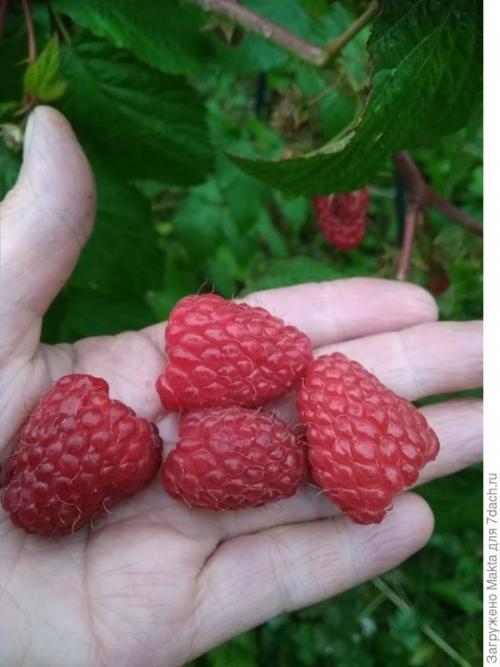

"Nizhegorodets" Its fruiting is always abundant and long-lasting. Another variety we have chosen is "Orange Miracle". Fruiting a week later, but also for a long time. The taste is sweet. Yellow berries are not pecked by birds.
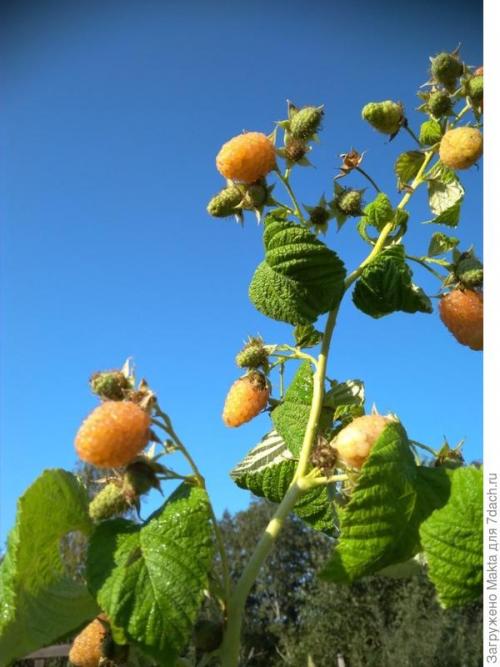

"Orange miracle" In our cool climate, it is enough in the spring to cover the soil around the bush with black material, as soon as the tops of the shoots appear, remove the shelter. This push for the Orange Miracle will help accelerate development. In the spring, we began to cover the corner of the raspberry tree with black covering material, throwing it onto the plastic mesh of the fence and securing it with ordinary clothespins. The length of plantings along the perimeter of the fence is 10 m, the entire raspberry grove (both common raspberry and remontant) is protected from northwestern winds. And all the raspberries began to bloom earlier and bear fruit better.
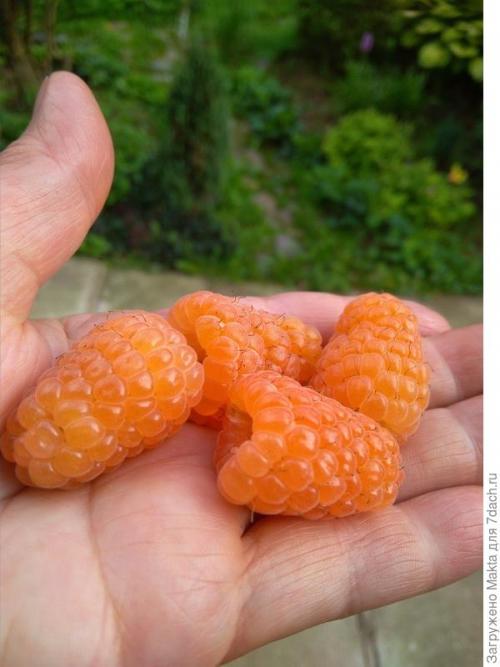

Orange miracle I do only herbal fertilizing with the biological product Shine, and also fertilize with liquid horse Orgavit. I never spill urea in the spring. Earlier, in spring and autumn, I laid vegetable food waste fermented in an EM bucket on top of the soil around the bushes, then covered them on top with foliage, dry broken sticks from the forest, hay, and rotted straw. During the winter everything rotted and settled. In the spring, I spilled it with a biological product, added more mulch. Ideally, this is how it should be. The raspberry tree should be soft like a pillow, in a sunny place, without stagnant water. And the raspberries were planted on rotten stubs hidden to a depth of 30-40 cm, the remains of hemp and again food waste. Now, due to the presence of a hunting burrow dog on the farm, it will not be possible to decompose organic matter. When pruning shoots, I scatter Orgavit granules and mulch, and this is easier and more pleasant for me. Sometimes I bury waste in the aisles. Life has made adjustments.In the last warm days of October, I spill the plantings with Metarizin to protect them from the invasion of pests next season. But then you do not have to spray the raspberry tree later, the shoots are healthy, the buds, flowers and berries develop normally. I will try to tell you about the planting separately, since with this method shoots do not creep, because raspberries are a "girl" very insatiable, loves to "eat", and can show agility in search of food.
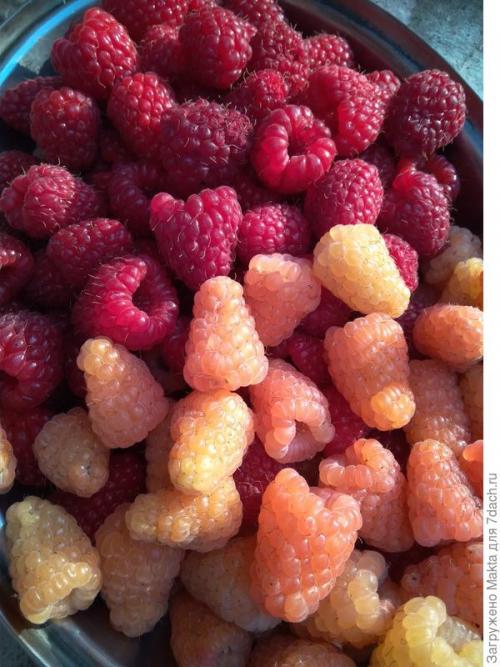

"Orange Miracle" and "Nizhegorodets" When ripe, "Orange Miracle" acquires shades of peach color and a wonderful raspberry aroma. The third grade of raspberry we have is the Firebird. Delicious, aromatic and fruitful. Shoots sometimes reach 2 meters, require support.


Firebird and blackberry Agavam And the last "our" variety - "Indian Summer", sweet, tasty and also fruitful. He bushes himself, so there are always a lot of berries. This is him in the first photo in an old vase. Growing techniques are the same for all varieties. Productivity largely depends on the growing conditions, on the care of the gardener, so it is enough to have 3-4 varieties to provide yourself with tasty and healthy berries. The sweet taste of the berries is entirely on the conscience of the variety and the sun, but with a reasonable number of shoots left for fruiting, that is, from three to five. That's the whole simple secret.
Follow-up care
Not only the correct planting of plants is important, but also further care for them, especially in the first months of life. The rooting and growth of the raspberry tree will depend on its quality and regularity.
- It is necessary to protect the bushes from different weather conditions.
- At lunchtime, the plantation is covered with a film that is pulled over the frame. This design will create an airspace that protects from winds, sudden cold snaps and snow in winter.
- On a small bed for each plant, you can build a separate shelter.
Garter
Usually it is carried out for bushes planted with a trench or tape method. Raspberries are tied to trellises immediately after disembarkation. This makes maintenance much easier.
For the construction of such a structure, it is necessary to take two wooden or metal pillars, drive in at the beginning and at the end of the row. A wire is pulled between them at a height of 1 m.If they are too long, an additional column is driven in in the middle. Tied up every 10 cm.
After two years of development of the raspberry tree, wire is added at the level of 0.3 m and 1.5 m. The lower row will be used to tie the young growth, the upper one - for the oldest and longest branches.
Watering
In the first 3-4 weeks, the seedlings require frequent watering, which will have a beneficial effect on the rooting and development of the root system.
During this time, they are moistened every other day - by sprinkling, watering from a bucket under the root or by a drip method. The latter is considered the most effective, since it provides each bush with the necessary amount of moisture.
A month after planting, they spill only as the earthen coma dries to a depth of 5-6 cm.
It is also worth considering the frequency of seasonal rainfall. Raspberries do not react well to overflows - their roots rot from excess moisture.
Loosening and mulching
This berry culture has a superficial root system, therefore, light loosening is required to a depth of 5-6 cm, and the next day after each watering. Together with this procedure, rows are weeded in parallel, weeds are removed.
Additionally, mulching is carried out with peat to protect the soil and roots from drying out.
Pruning
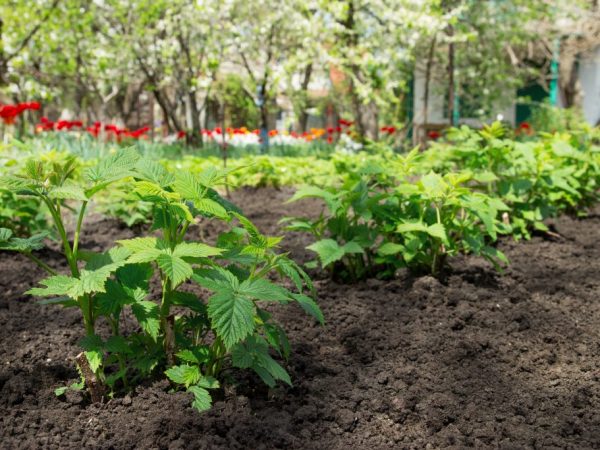

Pruning involves removing all diseased branches.
In September, a sanitary shearing of the bushes is necessary - all sick, broken, damaged by parasites and dried branches are cut out. To avoid infection, the cut sites are irrigated with copper sulfate.
You can also do a light shaping, prune old branches 20 cm in length to stimulate the development of young stems in spring.
Warming for the winter
- In the first years of life, the bushes are weakly resistant to frost, so they need to be covered.
- A week before the upcoming frost (in October or November), they huddle - they form a mound 15 cm high from peat or garden soil.
- Usually the tops of raspberries freeze. To prevent this, the branches need to be bent to the ground. They are bent in an arc and tied to the bottom of a neighboring plant.
It will not work to lay branches on the surface of the soil - they will simply break from this.
In winter, after snow falls, the bushes are covered with a snowdrift. The procedure is performed in frosty weather, when the snow is soft and fluffy. If it is wet and heavy, the shoots can break off easily.
Prevention of diseases and pests
Raspberries can be damaged by various diseases and pests, so that this does not happen, the bushes must be treated in late autumn with appropriate preparations.
- For bacterial, fungal and viral infections, fungicides are used - a solution of copper sulfate or Bordeaux liquid;
- To protect against parasites - insecticides (Actellik, Aktaru, Fitoverm or Fundazol).
Sprayed in dry and cloudy weather or in the evening when the sun goes down.
In case of defeat, all diseased organs are removed, then the bush and the soil under it are irrigated with the necessary pesticide.
How to properly plant raspberries in the fall in a planting hole or trench
Before starting to engage in direct planting, of course, you first need to purchase high-quality seedlings, decide on a suitable place on the site and choose a planting method. We will talk about how to do it right further.
What should be a seedling
In the fall, it is not at all difficult to get high-quality planting material. This is due to the fact that raspberries form many root suckers, which are used as seedlings.
A high-quality root offspring should have a well-developed fibrous root system 15-20 cm long.Its aboveground part should consist of several stems (annual shoots), with a base thickness of at least 1 cm.The appearance itself should be healthy, without visible damage from diseases and pests ...
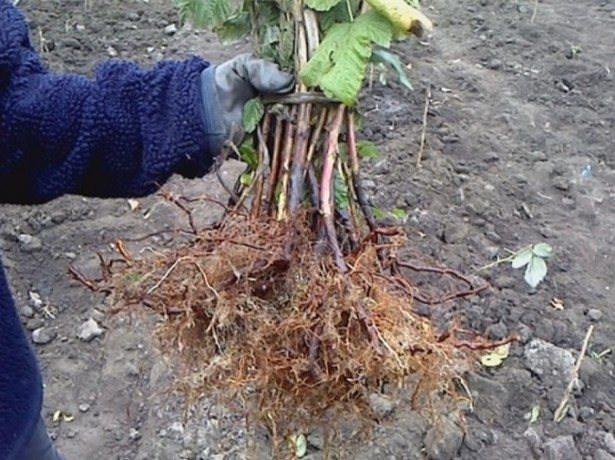

If the seedling is tall, then before planting it is cut to a level of 20-25 cm from the base. This is necessary so that it pulls less nutrients on itself, giving the root system the strength for rooting.
Note! If you want to plant or transplant a raspberry bush to a new location (and not buy and plant from scratch), then help you this material on raspberry transplant.
Pick-up location
Raspberries are one of the most sunlight-demanding shrubs, for which you will need to identify the most illuminated place in the garden... The thing is that with a lack of light, raspberry shoots stretch out, their lower part becomes bare, the number and size of berries decreases, and moreover, they lose their sweetness.
Of course, raspberries can grow in light partial shade (shading should be short), but if you plant a berry bush in a shady place, then you may not even dream of large and sweet berries, no matter how hard you try and feed your raspberry.
In addition, the site must be protected from drafts and strong winds.
For example, it will be just fine if, on the north side, the raspberry plantations are protected by a fence or some other obstacle.
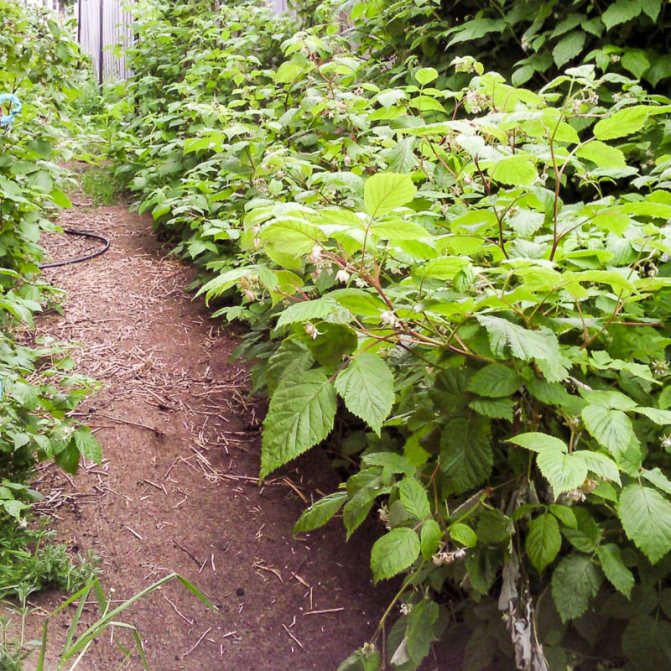

What soil is needed
The soil for planting raspberries should be sufficient loose and fertile.
Advice! Depending on the fertility structure of your land, when you start preparing planting pits or trenches, you will need to make sure to apply mineral and organic fertilizers.
This is due to the fact that the bush superficial root system, which can successfully develop only in cultivated (arable) land. Accordingly, raspberries are very demanding on soil moisture, therefore the soil must it is good to pass oxygen and moisture to the roots. At the same time, the water should not stagnate in any case, because the shrub does not tolerate strong waterlogging and high groundwater.
Prolonged stagnation of water and waterlogging of the raspberry tree lead to the death of roots and the subsequent death of plants.
Thus, the ideal soil for planting raspberries is loamy and sandy loam soil.
Optimal soil acidity for successful cultivation of raspberries - 5.5-6.5 pH (slightly acidic-neutral).
On alkaline or acidified soils, raspberries will just sit, and not develop and bear fruit.
Distance between bushes and rows
Raspberries are planted in such a way that a distance of 50-80 cm remains between the bushes (depending on which variety is vigorous or not), and in the aisles - 1.2-2 meters.
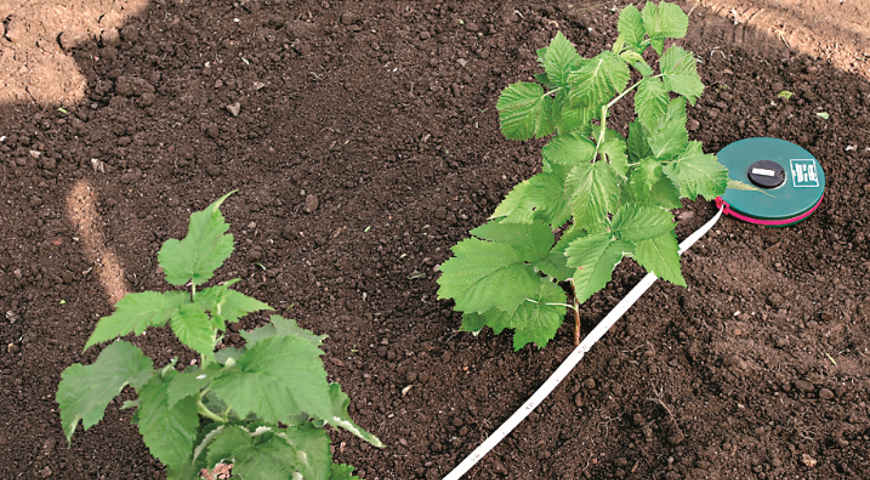

This distance allows you to conveniently harvest and take care of the berry bushes. In addition, plants planted at such a distance do not interfere with each other, they have enough food and sunlight (since the bushes do not shade each other).
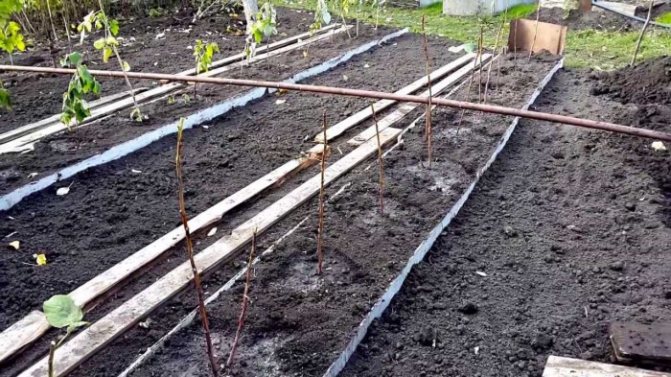

Landing pit and planting depth
As a rule, a hole 40-50 cm deep is dug for planting raspberries.At the same time, its width and length, as a rule, are also the same 40-50 cm. These dimensions of the planting hole allow you to make all the necessary organic and mineral fertilizers required for active growth and abundant fruiting of the berry bush.
The very planting of the seedling is carried out so that the root collar (replacement buds) is eventually at the soil level.
Direct landing
Step-by-step instructions for planting raspberries in the fall:
- Place the seedling in the center of the planting hole or trench on a small mound, and then gently and evenly spread its roots.
Make sure that the roots do not bend upwards under any circumstances.
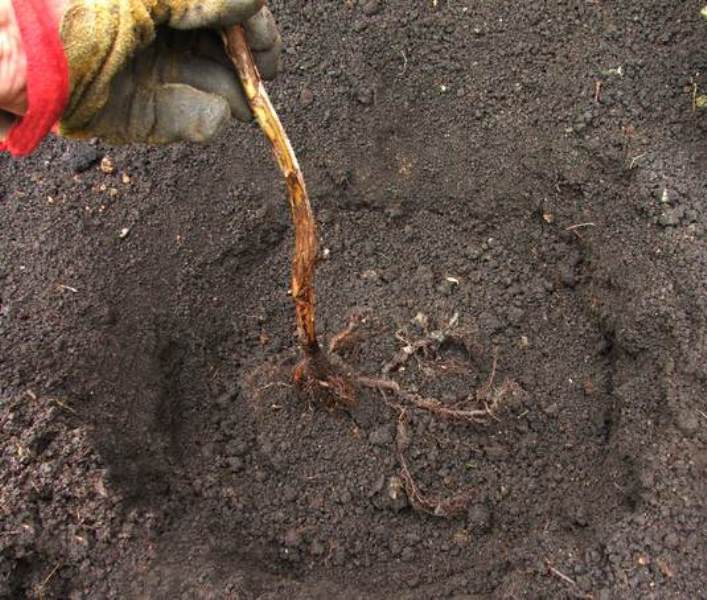

Interesting! Some experts recommend planting raspberry seedlings with an open root system directly in the slurry, and for this, first spill a hole or trench abundantly with water. You can also try this:
- Sprinkle with fertile garden soil mixed with humus (2 to 1).
Falling asleep with soil, it is recommended to slightly raise the seedling several times so that the roots come into better contact with the soil and no voids form around them.
As a result, the root collar (replacement buds) should be at the soil level.
- Compact the soil around the seedling.
- Spill abundantly with water (5-10 liters) to ensure maximum contact between roots and soil.
- The planting of the seedling is completed, but a couple of nuances remain, which will be discussed later.
Video: the correct planting of raspberries in the fall
Are there any differences in planting and caring for remontant raspberries
There are no differences in planting, but there are a couple in care and cultivation techniques.
The whole difference between remontant and regular raspberries is that remontant raspberries can bear fruit both on the shoots of the current year and the past, i.e. instead of one harvest, you can get two (1st time - in June-July, 2nd time - in August-September).
However, it is worth knowing that the second (autumn) harvest of remontant raspberries is less tasty, while the first (summer) harvest is not inferior to the taste of the usual (although many may disagree).
Nevertheless, it makes sense to have both regular and remontant varieties on the site in order to collect tasty and healthy berries both in summer and autumn.
Naturally, remontant raspberries are more demanding on light, watering and feeding than ordinary ones, which is quite logically explained by its greater fertility.
Video: features of planting and caring for remontant raspberries
Top dressing
Autumn care of seedlings includes the introduction of nutrients that will strengthen the roots of plants, provide them with good winter hardiness and protection from disease damage in the spring.
There are certain rules for fertilizing raspberry seedlings - organic matter must be alternated with mineral fertilizing in order to achieve higher productivity.
Each root nutrition is combined with watering. This will help the roots to absorb the active substances faster and better, as well as protect against burning with chemicals.
Organic
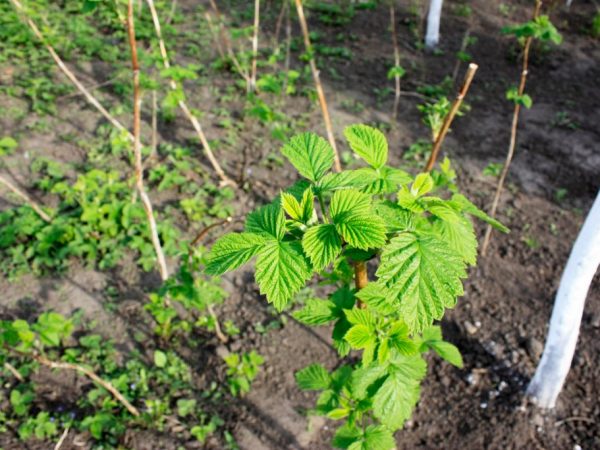

Organic fertilizers have a positive effect on yields
Usually gardeners use a solution of chicken manure, ash, peat, last year's manure or compost.These components decompose for a long time - their activity will manifest itself only by spring, which will have a positive effect on the growth and fruiting of bushes.
Fertilizers are applied in the fourth year of cultivation, provided that the necessary nutrients were laid in the pit during planting.
For autumn digging, you can add compost or rotted manure at the rate of 4-5 kg per 1 m². Then each plant is mulched with peat - the optimal thickness is 10-15 cm.
When feeding chicken manure, you need to be careful, since this is a highly concentrated fertilizer that can burn delicate roots. Prepare a solution in a ratio of 1:20. After that, abundant watering is carried out to improve the quality of nutrient absorption.
After picking the berries, wood ash (100 g each) is added to the trunk circle - it replenishes the lack of potassium, reduces the acidity level and helps maintain the soil light and loose.
In addition, green manure plants can be sown between the rows - they improve the structure of the soil. In a beveled form, they are buried in the ground in the fall. By spring, the green mass will rot and provide additional nutrition.
Mineral
After feeding on organic matter, mineral preparations are introduced the next year. The main task is to nourish the bushes with vital trace elements - phosphorus and potassium.
Nitrogen cannot be used, because from it the plants will grow even more, which is highly undesirable before the coming cold weather.
An excellent fertilizer is superphosphate, which contains potassium, calcium, phosphorus and sulfur.
First, the soil is loosened in the near-trunk zone, after which 55-60 g of granular agent is applied under each bush.
In combination with this top dressing, they feed with potassium sulfate - 40 g per one bush. Close up to a depth of 6-7 cm, then watered abundantly.
A good substitute for potassium can be potassium magnesium - 30 g per plant.
The dosage for raspberries from the age of 5 years is doubled.
Site selection and soil preparation
The best yield and excellent taste of berries are shown by a raspberry tree, broken in areas well-lit by the sun and protected from cold gusty winds.... In the shade, the fruits grow small and sour. It is not worth planting a shrub between large fruit trees, as the neighboring root systems may not have enough nutrition and the plants will oppress each other.
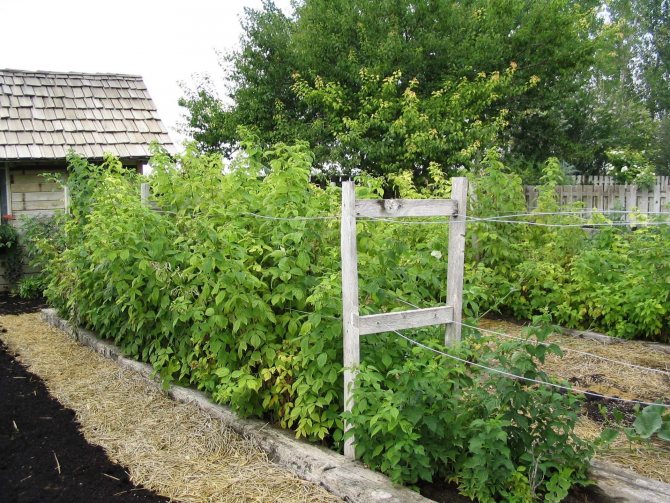

Raspberry loves sunny places
Experienced summer residents plant berry bushes on the south side along fences, fences or buildings (utility block, shed, bathhouse, etc.), stepping back about a meter from them.
Well-drained, fertile and water-absorbing loams or sandy loams with a slightly acidic or neutral reaction are suitable for raspberries. The culture can grow safely on sandstones, if they are pre-structured by adding clay (1 bucket) per 1 m2. Heavy clay soils are lightened by the addition of sand (1.5–2 buckets), peat (bucket), and a drainage layer of bricks, stones or rubble. The site should not be excessively damp, flooded with rain and thawed spring waters.
Raspberry is hygrophilous, but does not like the close occurrence of groundwater (closer than 1.2–1.5 m).
The selected area must be thoroughly prepared in advance (3-4 weeks):
- Dig it to a depth of at least 30–35 cm, carefully breaking up the clods and choosing the rhizomes of perennial weeds (bindweed, wheatgrass, sow thistle, etc.), as well as stones and all sorts of debris.
- In parallel with digging, apply fertilizers per 1 m2:
- superphosphate - 80–90 g;
- potassium sulfate - 55-60 g;
- charcoal - 200-250 g.
- Cover the prepared area with any opaque material (boards, roofing felt, slate, etc.) so that weeds do not germinate.
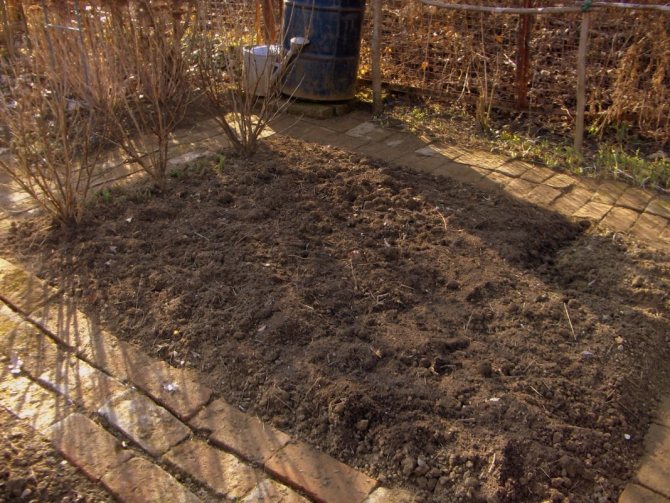

A place for raspberries must be prepared in advance
Typical mistakes
Many gardeners, especially beginners, make various mistakes when planting raspberries and during cultivation, resulting in a weak plant.
- Violation of planting dates - if the procedure is carried out too late, the seedlings will not have time to take root before wintering, after which they will die.
- The choice of unhealthy material - sick and poorly developed bushes slow down growth, practically do not bloom and give a meager harvest.
- Planting in the shade or on an area with a close passage of groundwater. Both conditions negatively affect the productivity of the bushes.
- Violation of the rules of application and dosage during the preparation of solutions - it is better to underfeed this culture than overfeed. The introduction of nitrogen fertilizers leads to an intensive build up of green mass, inhibits the development of new roots, flowering and the formation of berries.
- Raspberry dries up due to lack of moisture, in order to reanimate it, you need to adjust the irrigation system and be sure to add mulch after that.
- Deep loosening can harm the health of the roots - the plants begin to wilt, dry and quickly die.
- The lack of preventive treatments for diseases and parasites increases the risk of infection of the bushes in the spring.
How to plant: step by step instructions
To successfully plant raspberries, you must adhere to a clear algorithm of actions. Otherwise, the plants may not be able to withstand the long and cold winter cold.
What should be a seedling
The selection of seedlings must be taken very seriously. A choice mistake can lead to the death of the raspberry tree.
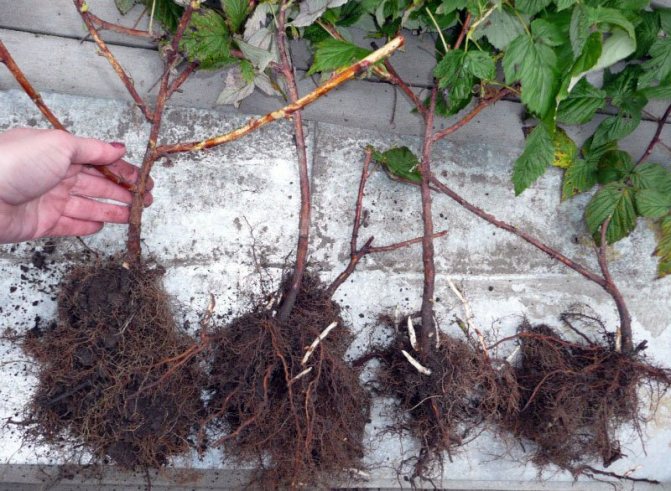

- The root system of a young shrub must be healthy and developed, without damage and rotten areas.
- There should be a large number of dormant basal buds on the roots.
- The seedling must have at least three stems.
- There should be no visible damage to the bush.
- The color of the stems must be woody.
- The diameter of the seedling should be about 1 cm in thickness.
Important! Long stems should be cut to 25 centimeters in length.
Pick-up location
Before organizing your raspberry tree, choose the right location for it. The site should receive a sufficient amount of the sun, but the rays of the luminary should not be direct, but scattered. If the plants are planted in the shade, then a large harvest will not work.
Also, the place for the bush should be well protected from the wind. This is done so that winter movements of cold air do not freeze the young root system. Spring breezes can also damage young raspberry leaves.
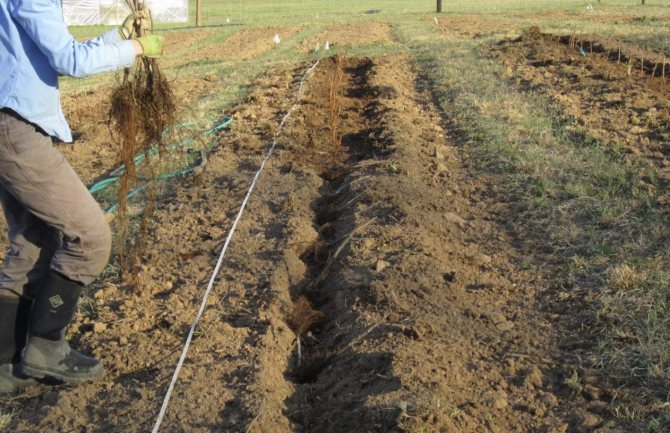

Soil requirements
Choose an area for your raspberry tree with sufficiently fertile soil. The soil must contain such important minerals as nitrogen and phosphorus, potassium and calcium salts must be present. Otherwise, the leaves of the bush will not be green enough, because of this, the process of photosynthesis will not be complete. By its structure, the soil of the raspberry tree should be sandy or loamy.
Site preparation
Before you start the process of planting raspberries, you need to carefully prepare the site.
To do this, you need to do the following:
- dig up the soil where the raspberries will be planted, the depth of loosening should be at least 30 cm;
- weed the soil by removing all weeds and foreign objects such as glass and plastic bottles, boards or stones;
- level the dug earth using a rake.
Important! Choose an area with good moisture drainage to prevent plant roots from rotting.
Ripening and harvest time
The growing season for raspberries begins in April, but the ripening period, depending on climatic conditions and varieties, can shift by 5-15 days.
| View | Variety names | Fruiting time |
| Early | Cumberland, Scarlet Sails, Sun, Polana | Mid to late June |
| Medium early | Hussar, Sweetheart yellow, Arbat, Pride of Russia, Kuzmin's news, Luck, Abundant | From late June to mid-July |
| Average | Latham, Chestplate, Shy | Throughout July |
| Mid-late | Peresvet, Tarusa | From late July to mid-August |
| Late | Companion, Arabesque, raspberry cut | From the second decade of August to the end of September |
The collection of berries is carried out for 1-1.5 months, then the two-year branches dry up and cut them off.
Raspberries can produce two, sometimes three crops. Estimated fruiting time:
- After trimming;
- At the stage of formation of young growth;
- In the flowering phase and 2 months after the end of budding.
The berries are harvested before frost.
Pros and cons of autumn planting of raspberries
Planting raspberries in the fall is beneficial for a number of reasons:
- Favorable weather conditions. In the autumn season, the heat is no longer there, it is warm during the day, and at night it is still not too cold. At the same time, the humidity is usually high. For confident rooting, such conditions are the most optimal.
- At the end of the growing season, all the vital juices of a raspberry seedling are aimed at the development of the root system, and not at the growth of the ground part, therefore it will take root better and winter more easily.
- In the markets, nurseries and gardening shops in the fall, the choice of planting material is much more extensive. It is easier to choose a variety with the desired characteristics, and prices are already falling.
- In the autumn, work in the garden is already not enough, so planting can be done slowly, carefully and according to all the rules.
- For the next season, it is quite possible to expect the first, although not a very large harvest.
A significant drawback of the autumn procedure is the need to closely monitor the weather, since there is a possibility of a sudden arrival of cold weather. Then the young plant will not have time to adapt to the new place and will not survive the winter. It is for this reason that it is not recommended to plant raspberries in regions with harsh climatic conditions (Siberia, the Urals, etc.).
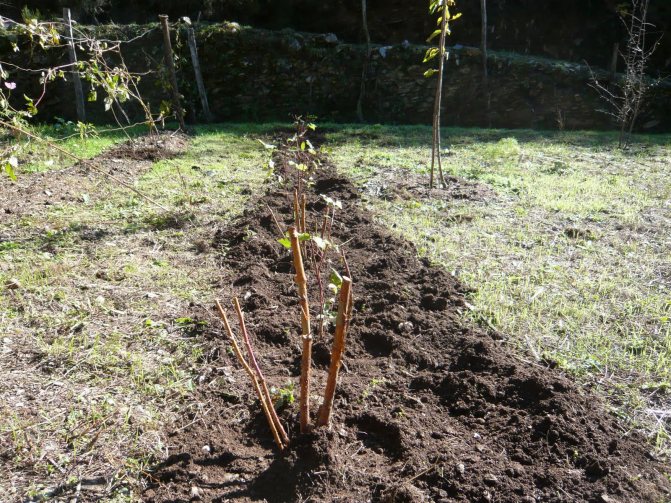

It is believed that planting raspberries in the fall is better.
Common mistakes gardeners make when planting and growing raspberries
Every gardener counts on the expected rich harvest of raspberries, but if the technology of its cultivation is violated, he will be naturally disappointed: the plants are developing insufficiently, the harvest is small, the berries are of poor quality. The reason for this is approximately the following errors.
- poor quality planting material;
- the time of planting raspberries before winter was chosen incorrectly: either too early - the buds will open and freeze; or too late - the seedlings will not have time to take root and get stronger before the frost;
- raspberries are planted in the shade;
- requirements for crop rotation are violated;
- incorrect or insufficient fertilization was applied during planting;
- the necessary spacing between bushes and rows is not observed, which leads to thickening of plants, to a decrease in ventilation and fungal diseases;
- lack of sunlight on the side shoots - small and unsweetened berries;
- deepening of the root collar, which leads either to the death of the bush or to the absence of root suckers on it;
- placement of the root collar above the norm, which leads to drying out of the root system, especially in the dry summer period or during the frosty period in winter;
- the correct pruning of shoots after planting is not performed.
As you can see, planting raspberries before winter requires the systematic implementation of the rules listed in this article, sufficient horticultural intuition, knowledge of the characteristics of the planting site, and its correct choice. And most importantly, the desire to grow beautiful healthy raspberry bushes and get a fragrant, vitamin and very tasty harvest of raspberries, excellent in all respects. And do not forget to cook our favorite raspberry jam to be proud of our harvest even in the cold season.

